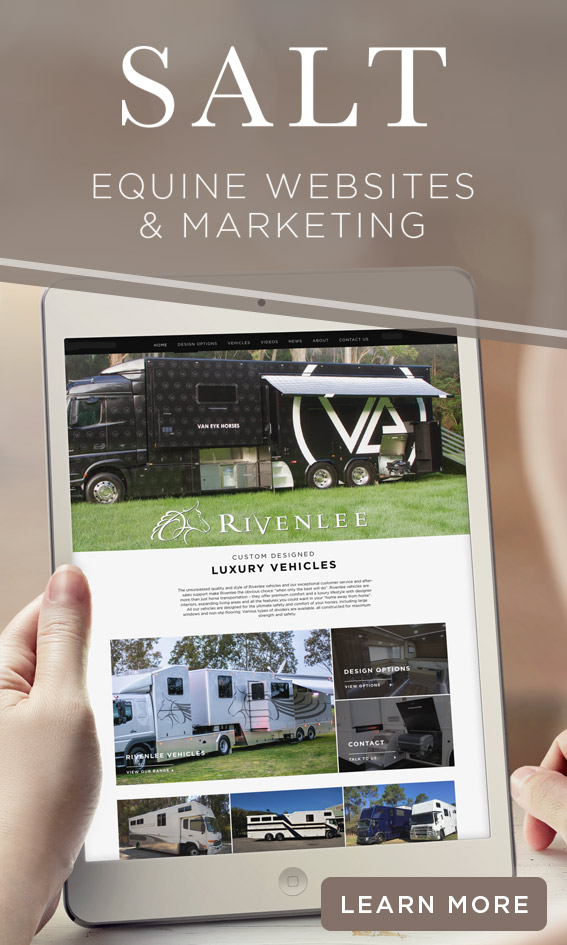The making of a Grand Prix Jumping Horse – Part 1: In the beginning

Above: Vivtania (Vivant/Quintana) 1/2 sister to Conquistador with her beautiful Clinton filly.
Brains, confirmation or bravery? The question of what makes the ultimate Grand Prix jumping horse is one that has been on the minds of breeders and riders for years. We have many high quality horses in Australia, some of which have been imported from Europe and some bred locally, but regardless of their origin, to get any horse to Grand Prix level and keep them there for an extended period of time is certainly a combination of good training, good management and a little bit of luck.
In this series we are going to examine the key stages in developing a horse to Grand Prix level and the numerous factors, considerations and costs to be considered throughout the process. We have undertaken some in-depth conversations with key players on the Australian jumping scene, including breeders, trainers and riders to pull together as much detailed information as possible to allow us to shed some light on what goes into the making of these special horses.
In the first part of this series we start at the very beginning and look at what is involved with breeding a Grand Prix horse. We went straight to the experts for the information and caught up with Helen Chugg from Diamond B Farms to find out more.
What to look for when choosing a sire and dam
The choice of sire and dam is a very personal one, however it is clear that jumping talent is highly heritable. A very good dam line is essential and one of the most challenging aspects. The choice of the stallion is somewhat easier as semen is readily accessible with a large choice both nationally and internationally. In Helen’s words ‘start with good mare lines that have proven themselves in the ring over 1.30m – 1.40m and then add a good stallion that would suit that mare and add some scope and heart.’
The aim is to try to improve on the mare with a stallion that compliments her strengths. For example, if you have a hot mare you might look for a stallion with a particularly good brain and rideability. But opposites are not the way to go. You are not going to put a small short legged mare to a tall long legged one and get the perfect ‘mix’ of medium height with length of leg.
We also learnt that you should look back 3-4 generations at a minimum, that the smallest characteristics are inheritable and ‘you can’t make a horse be something it is not’. We asked Helen for the main things that she would look for in breeding stock and she gave us the following list:
- Heart (hard to define but really about the will to win);
- Courage;
- A good frame that stays sound; and
- Jumping talent – a horse that is watchful and intelligent and naturally wants to be careful.
Amanda Madigan and Diamond B Vivienne
The breeding process
Because of blood lines, some mares, after they have proved that they are rideable and sound, are kept back for breeding purposes, from 3 or 4 years of age, before they become a competition horse. Unless you are going to use a surrogate mare you need to take into consideration that breeding takes 2 years out of a mare’s competition life.
Responsible and ethical breeding is not a cheap process and for stallions you are looking at between $1,500 and $2,000 for a service fee and frozen semen can cost between $2,000 and $4,500 when imported from overseas (it can also be more difficult for mares to fall pregnant to frozen semen). If you are considering embryo transfer, you will also be looking at between $4,500 and $6,000 in vet fees. Additional vet fees (around $800) are involved with mare scanning and follicle testing, including 14 day and 45 day pregnancy tests. A mare’s pregnancy normally lasts 340 days.
Diamond B Farm’s young grand prix mare Vivienne on the right [Vivant/Conquistador] with her daughter Beyonce by Baluga who is just starting her under saddle career.
Advertisement
Buying a foal or young horse
Instead of breeding, you can obviously buy young horses as foals, yearlings and. even 2 or 3 year olds. It is essential that you always buy animals from an ethical breeder – one that breeds animals which have a purpose and are bred to be healthy, well built, with good limbs and a strong pedigree on both sides. The purchase price of young horses obviously varies and you need to be realistic about the type of horse you are looking for. Prices can vary but as an indication you could be looking at between $12,000 and $40,000 for a foal and between $20,000 and $100,000 for a three year old, depending, of course, on pedigree, type and market demand.
In the next part of this series we look at what it takes to start and bring on a young jumping horse and we speak with Jess and Rhys Stones about this very important part of the process.
Vivtania (‘Little Quinny’) – Vivant/Quintana.
Half sister to Conquistador.

Volley – Vivant/Colthaga.
Half sister to Caracas.














